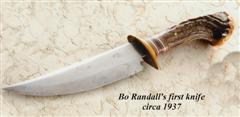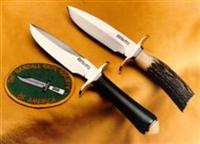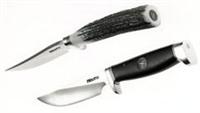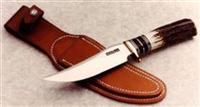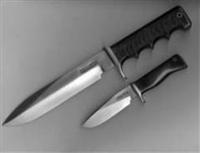Joe,
Agreed: No difference between a WWII 7" Heiser sheath and one just post war up through mid '46 with the
one exception that the very early post war sheaths had oversized throat rivets for a few months. The knife you posted: Are you saying it's a 7" WWII Hunter? It looks more like a 6" blade! Also, what kind of a nut on the butt? If it's not brass, it's not a WWII Hunter.
Your WWII Commando sheath: We've had this discussion before: I say the accompanying sheath with large throat rivets is a replacement if indeed the knife was made prior to mid '45. Let's just leave this that we agreed to disagree.
Following are some photos of some 7" post war 3's and 4"s to give you an idea of the general "sweep" differences (I'm posting 7 inchers and not 6 inchers as the extra 1" allows more room to sweep):
1. This is an early post war 3-7 by virtue of the oversized throat rivets and small stamp. It's the same knife that is in Sheldon's book on page 27 (Note that it was incorrectly identified as a Model 4. It has a "hump" coming off the hilt confirming it is a Model 3). Very little upsweep. I would not call it a "3 1/2".

2. This is an early post war 4-7 by virtue of the oversized throat rivets and small stamp. Certainly more upsweep than the previous 3-7, but not as exaggerated as later 4-7's from later in the decade.

3. This is an early post war 4-7 by virtue of the oversized throat rivets and small stamp. Certainly more upsweep than the previous 3-7, but not as exaggerated as later 47's from later in the decade.

4. This is a 3-7 from C 1948 (Page 38 in Sheldon's book). It has the same transition sheath as Tune's 3-6. A bit more upsweep, but again I would not call it a "3 1/2".

5. This is a 4-7 from C 1948. You can see the exaggerated sweep of this deep belly knife. Quite a difference from the C 1948 3-7 above.

6. Here are five 7 inchers. The first three are Model 3's. The last two are Model 4's. First is a WWII Hunter, the 2nd is a mid '45 to mid '46 3-7 with a wide blade and a small stamp (The corresponding sheath had small throat rivets), the 3rd is knife No. 4 above, the 4th is knife No. 5 above and the 5th is knife No. 2 above. This will give you a better perspective of the relative "sweeps" between 3's and 4's from the mid to late 40's.

7. Here is a pic of eight Model 3's spanning the years from 1944 to 1948. I guess you could say some of the were "3 1/2's", but the majority are within the norm for Model 3's. Some of the Model 4's pictured above could actually be called "3 1/2's".

8. Just for grins, here is a pic of a WWII Hunter with a sweep every bit as pronounced as a Model 4. In Gadis' book on page 105, he talks about the development of the Model 4 and his memory of a guy who wanted a larger upsweep for skinning during WWII. That knife must have been similar to this one:



